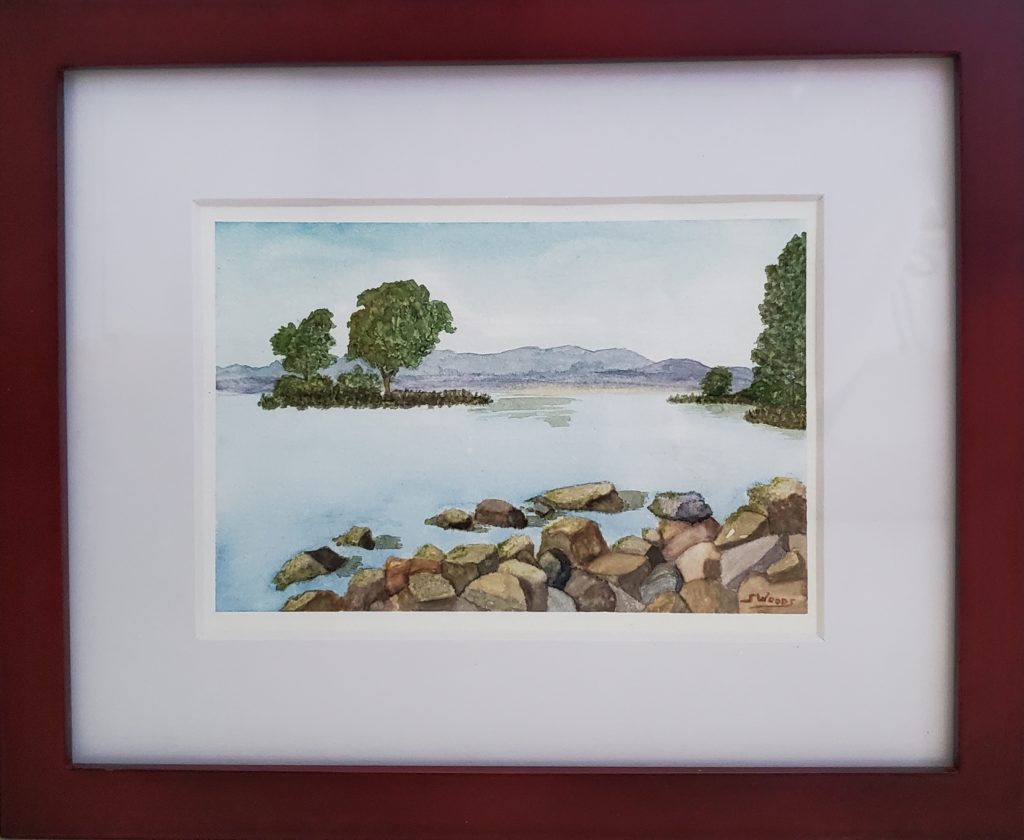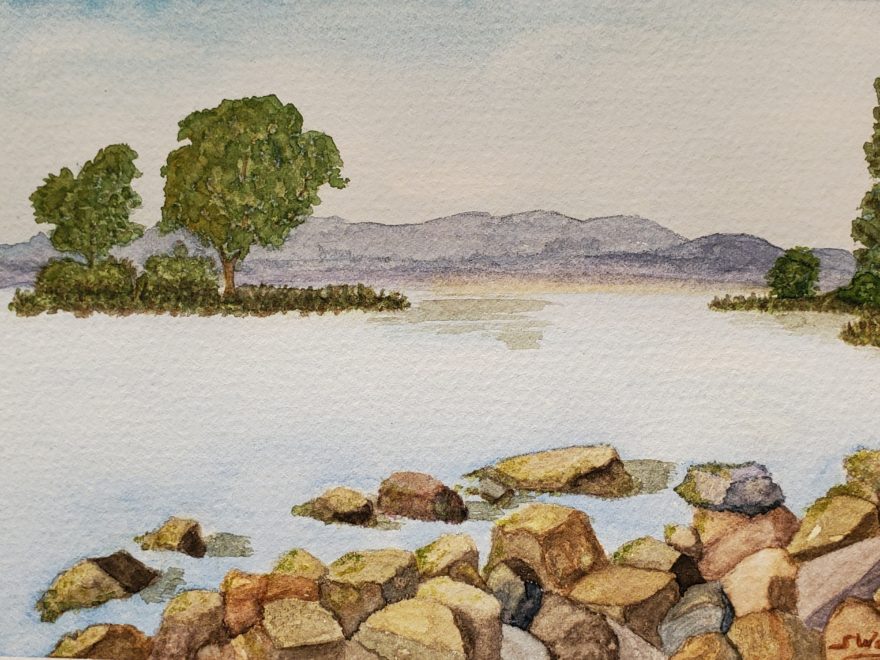Today I did something different, something completely new for me, at a local hospital. If it was “different”, then it obviously wasn’t another medical appointment or test for my rare disease! Nor did I attend a research meeting, as either a Patient Partner or a bioethics professional. It wasn’t a patient privacy protection event either, which is one of my sub-specialties within bioethics – along with clinical research ethics.
So, what exactly was I doing at the hospital today? I was there to donate one of my watercolour paintings! About six weeks ago I offhandedly offered to donate one of my watercolours to our local community hospital’s fundraising foundation. The foundation will be running two Silent Auctions this fall, at upcoming fundraising events; at a golf tournament this month, and then at a charity ball in November.
I know one of the organizers from school, and she had posted on her social media back in July that the charity was having some trouble getting donations of products and services this year. Too many businesses have been hit with COVID-19 losses recently, despite some fantastic initiatives from the Canadian government for small- & medium-sized companies.
So, I’d replied: “It’s too bad I’m only a beginner with watercolours, as I’d happily donate a painting for such a good cause.” This year all funds raised from these charity events will be earmarked for our community hospital’s Oncology Clinic, which treats over a thousand local patients each year. Definitely a good cause!
Well, it turns out that the hospital foundation liked my artwork and got back to me about my offer to donate a painting. I thought donating a painting would be something quick to do, but I was wrong. First off, the donated watercolour would have to be framed; watercolour paintings are usually framed behind glass to protect them from moisture. If a watercolour gets wet, or too damp, the pigment (paint colours) may run.
We agreed that I’d email them photos and descriptions of five of my smaller paintings, so that they could pick the one they liked best for their charity auction. I rushed out to pick up an assortment of frames, in different colours and sizes, at a local art supply shop. After explaining to the shop employee what I was doing, she suggested that I use convertible frames which could either be hung on a wall or sit on a tabletop or shelf. They wanted the painting by the first week of September, so I didn’t have much time to get it ready.
The next step was deciding which of my watercolours to put into these frames; that was a challenge in itself! I’m just starting out with painting, so am creating watercolours based on what catches my eye or inspires me – but I don’t have a clear idea yet of what others like. It’s a bit different from taking nature photos, which I’ve been doing for much longer. I’ve had some photos do well, for example in an exposition and a contest, but haven’t had that kind or exposure or feedback on any of my paintings yet.
What I finally decided to include in my selection were five completely different watercolours; a realist plein-air landscape, 3 semi-abstract animals, a fully abstract painting, and a more impressionist landscape. The hospital foundation chose the one I’d hoped they would; this little plein-air painting that I started at a local nature park in July, during one of my bike rides, and then finished outside on my patio.

Because I’d never donated a painting before, I checked to see whether there was anything specific that I had to do – from an artist’s perspective. Turns out, there was quite a lot of what I’m calling “art-ministration” involved; that’s what I’m calling art-related administration ‘-)
First off, I had to include a Certificate of Authenticity (CofA) with my painting even though I was donating it rather than selling it. That’s in part because Canada has relatively stringent copyright laws for artwork – including smartphone photos. (1) When a Canadian artist sells their artwork, they get to keep the rights to reproduce it; for example, the right for me to post a photo of my painting here on the blog!
There are exceptions for commissioned paintings and other special contracts for artwork, but that’s not the case with a donation. Which meant that I’d have to issue a CoA, even though I wasn’t technically selling my watercolour. Then I realized that I should make my CoA bilingual, English and French, because I wouldn’t know who’d be bidding on the painting.
Living in Montréal means that I’m used to preparing documents in both English and French, so I translated my CoA. I took some English/French translation courses in college, to be able to do this, but I’m not a certified translator. For a donated painting, my translation would be good enough.
Then it occurred to me that I should finish writing my Artist Statement, which I’d planned to draft in such a way that it would help raise awareness of my rare disease and of chronic pain in general. Although Artist Statements were mentioned during one of my art classes, I’d never finished it. Nothing like a deadline to force a person to get things done, right?
I’m happy with how my Artist Statement came out, and with my translation of it into French. With thanks to my sweetheart, as always, for checking my translation. It’s his first language but my second, so we tend to speak “Franglais” (sometimes also called “Frenglish”) at home; a mix of English and French, in which we alternate between languages even within the same sentence. (2)
Once I had finished translating my CoA and Artist Statement, I thought I was done with the art-ministration. Then I realized, after chatting online with another artist, that under Canadian copyright law the hospital foundation wouldn’t be allowed to print or post any photos of my painting in their Silent Auction materials. To allow them to do this, I wrote and translated a third document; granting the foundation limited rights to reproduce my watercolour “for purposes related to the planning, administration, and advertising of a Silent Auction to benefit” the hospital.
Luckily my career has often involved the drafting of legal language, so I had a starting point for this art-ministration adventure. Two of my jobs included managing companies’ philanthropic giving programs, so I have well over a decade of experience in handling donations from a corporate perspective. That was also very helpful. But donating artworks, as an artist? This was all new to me.
My art-ministration adventure was also complicated by the fact that since late 2018 I’ve been living with a mild cognitive impairment. That’s one of the results of my rare autoimmune and neuro-inflammatory disease… so it has been a challenge for me to write and translate all these documents within a restricted time frame. These cognitive issues slow me down, as I can only concentrate enough – especially on legal language or translations – for a few minutes at a time.
With all this, I was very happy to meet the hospital foundation’s deadline. This morning my husband and I dropped off my donated watercolour, and all three translated documents, with the person responsible for organizing their upcoming Silent Auctions.
Now I simply hope that my watercolour will help them raise some money for our community hospital’s Oncology Clinic. It’s a fantastic feeling to be able use my artwork not only to raise awareness of Complex Regional Pain Syndrome (CRPS), but also to help my local community hospital. And I have to admit, it has been interesting to learn more about the art-ministration involved in donating artwork.
As always, thanks so much for stopping by. I wish you well-being and safety, and moments of joy and happiness throughout your day. Look after yourself, because you deserve it. If you’d like to comment on this, please reach out via my social media accounts; I’ve had to disable the comments feature here on the blog because it was too much to manage with my cognitive issues – but I love hearing from you!
References
(1) Government of Canada. The Copyright Act, Amended 01 Jul 2020. Interpretation: Definitions; (2) artistic work. Website: Updated 26 Aug 2021. Online. Accessed 08 Sep 2021:
https://laws-lois.justice.gc.ca/eng/acts/c-42/fulltext.html
(2) Chahinez Dib. In Montreal, we speak franglais: How a mélange of French and English gives rise to a unique cultural language. The Link. The Link Publication Society Inc.; Concordia University. 13 Jan 2021. Online. Accessed 08 Sep 2021:
https://thelinknewspaper.ca/article/in-montreal-we-speak-franglais

